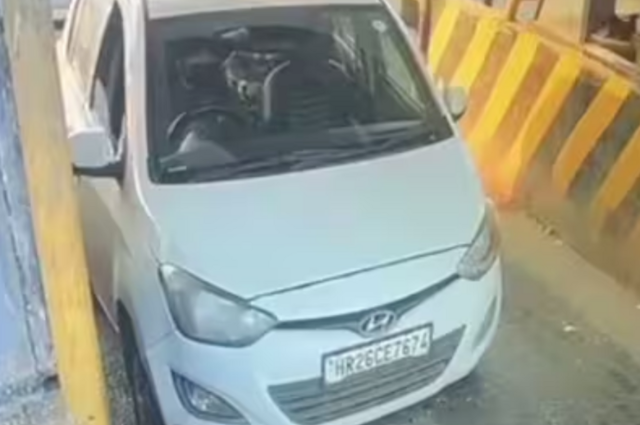
On the evening of 10 November 2025, what began like any ordinary rush-hour moment near the Red Fort Metro Station spiralled into one of the darkest incidents Delhi has witnessed in recent years. Cars slowed to a halt at the red light near Gate No. 1, pedestrians hurried across the road, and commuters filtered in and out of the metro, all part of a city constantly in motion. Then, in a matter of seconds, that familiar rhythm collapsed. A white Hyundai i20 waiting at the signal exploded with tremendous force. The boom echoed through the narrow lanes, startling those inside the metro station and sending people on the road diving for cover. Smoke enveloped the intersection, flames shot through twisted metal, and the air filled with the sharp mix of dust, fire, and terror. By the time the flames were brought under control, Delhi realised it was not witnessing an accident. It was an attack.
What Happened That Evening
Videos captured by bystanders show a sudden flash followed by a heavy cloud of smoke spreading across the road. Panicked pedestrians rushed to pull the injured away from burning vehicles. The explosion damaged multiple cars around the Hyundai and left the intersection in complete chaos. By the next morning, officials confirmed a grim toll. Thirteen people had died, and several others were receiving treatment for serious burns and trauma-related injuries. Emergency teams arrived quickly, but the force of the blast made rescue operations overwhelming. Firefighters fought back the flames while police and medics worked to move survivors to safety. For many who witnessed the event, the deep, disorienting roar of the explosion is something they say they will never forget.
The Investigation So Far
Authorities announced within hours that the explosion was being treated as a terror-linked incident. The case was registered under the Unlawful Activities (Prevention) Act and the Explosives Act. The National Investigation Agency took charge of the investigation. Initial forensic reports revealed that the car contained ammonium-nitrate-based explosives, a material often used in improvised explosive devices. Investigators believe the bomb may not have been fully assembled. This could explain why it detonated at the traffic signal instead of being driven into a more densely crowded area. This detail gains significance in the context of a major security operation conducted recently. Authorities had seized nearly 2,900 kilograms of explosive materials from a suspected terror module operating across multiple states. Officials are examining whether the dismantling of that module forced the handlers to act hastily, triggering an early, unplanned detonation. Another critical focus is the identity of the person inside the vehicle. One of the leads being pursued points to a Faridabad-based doctor who was previously linked to the disrupted terror network. Because of the condition of the remains, DNA testing is being conducted before confirming any identity publicly. Investigators are also reviewing CCTV footage from nearby shops, metro entry points, and traffic intersections. The goal is to trace the car’s route and understand where the explosive device was assembled and who else may have been involved.
Government and Security Response
Security across Delhi was tightened immediately. Metro stations increased their bag checks, police checkpoints appeared across major intersections, and airports and popular markets saw heightened screening. Home Minister Amit Shah condemned the explosion as a terror act and assured that those responsible would face the full consequences. Delhi Chief Minister Rekha Gupta announced a compensation of ten lakh rupees for the families of the deceased and support for the injured. She also emphasised strengthening surveillance infrastructure in high footfall areas. Security experts noted that this is the deadliest terror-linked blast in Delhi since 2011. The attack has reignited concerns about sleeper cells and underground networks operating within the region.
Why This Attack Feels Different
The location has left many residents unsettled. The blast occurred near one of India’s most iconic heritage sites, a place deeply tied to national identity and collective memory. Many people assumed the area to be among the most secure in the city. The attack has raised uncomfortable questions about possible vulnerabilities and unnoticed gaps in security protocols. The nature of the incident also suggests that a far larger plan may have been in motion. Investigators believe that if the bomb had reached a crowded public area, the casualties could have been significantly higher. This lingering sense of what might have happened is what has left many residents anxious.
Yet, amid the fear, the spirit of Delhi revealed itself. Strangers helped the injured, shopkeepers rushed out with water and first aid, and residents checked on loved ones throughout the night. The city was shaken but not defeated.
Looking Ahead
As the investigation continues, the city waits for answers. The blast has reopened crucial conversations about preparedness, surveillance, and the silent risks that urban spaces often carry. What we know today is only the beginning. What the investigation uncovers in the coming weeks will shape not only the case but also Delhi’s sense of security and resilience. Despite the fear and uncertainty, one truth remains. Delhi has rebuilt itself before, in the face of violence, tragedy, and attempts to break its spirit. It will do the same again.
. . .
References:
